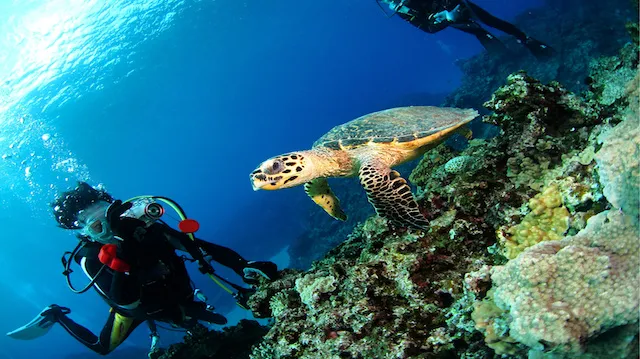I grew up on the shores of the Patuxent River in Maryland. My grandparents had a house right on the riverfront. They also had a pier and a boat. Needless to say, I have spent a lot of time in and around the water. I have water-skied, jet-skied, canoed and kayaked, among many other watersports. Unfortunately, one of the few things I have not had the privilege to do thus far is scuba diving!
Scuba diving has always fascinated me. I love the idea of being able to sink deep beneath the surface of the ocean and stay underwater longer than I ever could on my own. I would explore underwater caves or sunken vessels. I would drift along with dolphins, sharks, whales, turtles, eels… the list is just too long!
This is a dream of mine, but for Fabien Cousteau, exploring the ocean was his entire childhood! With a great explorer like Jacques Cousteau for a grandfather, Fabien grew up living and breathing the ocean every day. He began diving at the age of four, and at 48, he doesn’t seem to be in any hurry to stop. Spending a month on the ocean floor in the NOAA Aquarius Reef Base and piloting a personally designed, one-man, shark-shaped submarine are among his many underwater accomplishments.
Swimming with the sharks
Fabien built a 14-foot-long, single-seater submarine and disguised it as a shark. He called it Troy. The name is a clever play on the Greek myth of the Trojan Horse — a giant, hollow, wooden horse statue that allowed the Greek army to infiltrate the impenetrable city of Troy.
While similar in concept, Fabien Cousteau had more honorable and innocent motives for building his shark-shaped submarine. His shark-sub allows him to “swim” right up to sharks undisturbed, and study their behavior at very close range. He apparently got the idea from the classic comic book, The Adventures of Tintin.
Fabien has even taken the sub out at night, a very risky undertaking. He knew the dangers, but he also knew that in order to achieve great things, you sometimes have to take chances.
One month under the sea
Fabien’s most recent endeavor was to spend an entire month at the bottom of the ocean in the NOAA Aquarius Reef Base. The base is located off the coast of Key Largo, Florida, at around 60 feet below the surface. Thirty-one consecutive days are more than enough time to observe some pretty incredible things, and Fabien certainly saw his fair share.
One night, the team’s cameras captured images of a 600-pound grouper attacking a four-foot-long barracuda. Fabien had never seen this type of behavior from these fish before. He and his team also observed huge bodies of tiny plankton. The blooming plankton would often look like tornadoes or snowstorms as they swirled around the reef base.
Underwater phenomenon
Spending so much time underwater, Fabien observed some odd physical occurrences of his own. His hair grew much faster, and he said the air seemed to be much thicker, even syrupy, which made whistling out of the question! He also lost his sense of taste, but he said that thankfully it came back when he returned to the surface.
However, for Fabien, these things were a small price to pay for the ability to dive so frequently. The team was able to dive between six and 12 hours a day. In the 31 days they were underwater, they were able to collect the equivalent of around three years’ worth of data.

Perhaps someday the technology will be advanced enough for that. For now, we do the best we can with what we have, and I think it is safe to say that Fabien Cousteau does much better than most.
—Kyle Kramer
Kyle is an outdoor enthusiast with a passion for nature and sustainability. When he is not writing, you will find him in his workshop crafting with local wood, hiking in the Arizona mountains, fly fishing, horseback riding or putting together a healthy meal in the kitchen.
Sources:
http://www.biography.com/people/jacques-cousteau-9259496
http://www.redbull.com/us/en/adventure/stories/1331666214332/fabien-cousteau-inteview-and-noaa-aquarius-reef-base
